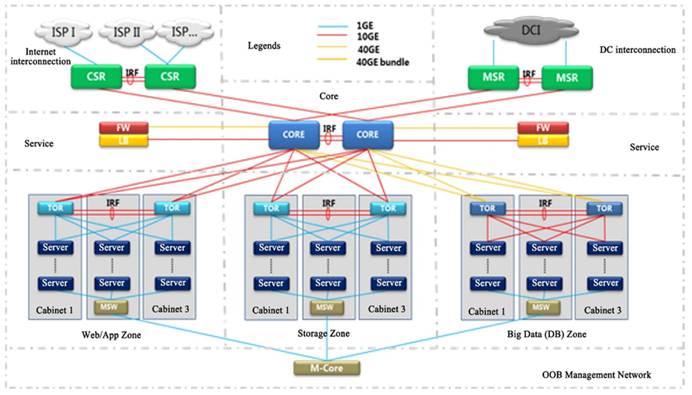Internet Data Center Internet Video Service Solutions
OCT 8, 20181. Introduction
With the increasing adoption of the Internet and rapid upgrading of Internet infrastructure, Internet video usage has grown apace, with usage of Internet video applications reaching 69.3% of total internet traffic. Video playback has become the main application of the Internet, and after nearly 10 years of development the Internet video industry has entered a stage of explosive development.
Internet video service enterprises include video sharing, long video streaming, Internet TV, B2B network video services and so on. Their core is provision of streaming media services – mainly video-on-demand, and video playback – a function whose characteristics are wide coverage, high concurrency and high traffic. Both traditional networking and business models have difficulty fulfilling these requirements, which significantly impact network operation. Thus planning and design of IDC network architecture for Internet video services has become the core technology problem faced by Internet video service enterprises. This paper analyzes the problems involved, and presents solutions to each of these.
2. Business Analysis
2.1 Web and App Services
Internet video enterprises mainly provide online streaming media services. Front-ends mainly include Web and other apps, allowing video uploading and sharing, transcoding, delivery of streaming media services, and account management. The main focus of these front-end services is user service access, and internal resource scheduling and orchestration. They are characterized by high concurrency, sensitivity to delay, and relatively low traffic. To adapt to the browsing and playing habits of large userbases, distributed clustering and load balancing techniques must be adopted.
2.2 Big Data Services
Big data services mainly include precision advertising, user analysis, content recommendation, search, ranking, and so on. In-depth analysis and data mining of user behavior are carried out in combination with machine learning, and iterative computing, using Hadoop and other related technologies. Operational data covers playback, user interaction, search, advertising and the like. As the amount of data increases, parallel computing has become increasingly popular. The biggest challenges faced by big data services are requirements regarding network I/O, caching and latency.
2.3 Storage Services
Internet video service enterprises require massive video and operational data resources. As their operations continue, data storage requirements increase, potentially reaching PB levels. Thus data storage becomes the critical factor. The biggest challenge faced by storage services are related to their reliability and scalability requirements. They also face certain levels of network I/O requirements.
2.4 Content Distribution Services
Internet video service enterprises' provision of online streaming media services to a wide range of audiences worldwide, and emphasis on user experience, have made efficient distribution of contents to users a critical question, imposing huge demands on bandwidth and ISP access. Only through employment of content distribution network (CDN) technology is wide-coverage provision of high quality services possible - IDCs are not up to the task alone. Using CDN technology, contents from providers can be pre-distributed to outlying networks, local networks and other places proximal to end users, delivering effective improvements in user experience. CDN imposes high network I/O requirements.
3. Design Solutions
3.1 Overall Planning
The analysis of Internet video service enterprises' business presented above demonstrates that, despite their variety, services can be broadly classified based on varying business requirements, as follows:
- Web and app services, with light traffic and high concurrency needs, should to be supported by distributed cluster technology;
- Big data services, with their high network I/O and real-time performance demands, require network caching due to problems related to their many-to-one congestion model;
- Storage services mainly impose demands in terms of high reliability and scalability, along with certain network I/O requirements;
- Content distribution services depend upon CDN technology for delivery. Whether built or rented, all offsite CDN centers face relatively high network I/O requirements;
- Given the huge differences in the network requirements of different services, suitable network architecture should be designed accordingly;
- The rapidity of growth and change in the Internet video service business, implies that any architecture adopted must have good scalability.
In summary, overall planning of IDC network architecture should conform to a model allowing for functional partitioning of different business areas, which have their own requirements in terms of network latency, reliability, and scalability. Thus, the network with a multi-activation flat architecture should be adopted. Finally, network access port specifications and architecture convergence times should be selected to suit to the varying network I/O requirements of each service.
3.2 Design Topology

As shown above (Figure 3.2-1), this is a two-tier architecture overall, with design partitioned according to specific business and other IDC functional requirements. The details are as follows:
- Internet Interconnection Zone: responsible for the interconnection between the IDCs of Internet video service enterprises and the Internet, with Global Server Load Balancing (GSLB) deployed as necessary where there are multiple IDCs;
- Data Center Interconnection Zone: provides interconnection between IDCs, and between IDCs and CDN nodes of Internet video service enterprises;
- Service Zone: provides IDC security and application delivery for Internet video service enterprises, including traffic cleaning, load balancing, and so on;
- Web & App Zone: deals Internet video service enterprises' Web & APP deployment requirements;
- Storage Zone: responsible for storage business activities;
- Big Data (DB) Zone: deploys Internet video service enterprises' big data services
- Out-of-band Management Zone: responsible for IDC management networking
4. Recommended Products
Interconnection Zone | SR8800-X/CR16000+Firewall & LB module |
DC Interconnection Zone | S9800/S10500/S12500-X, SR8800-X/CR16000 |
Service Zone | F50X0/M9000, L1000/L5000 |
Core Zone | S9800/S10500/S12500-X |
Web & App Zone | S5120/S5130/S5560 |
Big Data Zone | S5820V2/S6300/S6800 |
Storage Zone | S5120/S5130/S5560 |
OOB Mgt. Zone | S5110/S7500E |